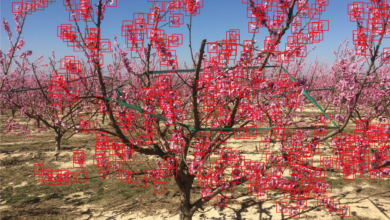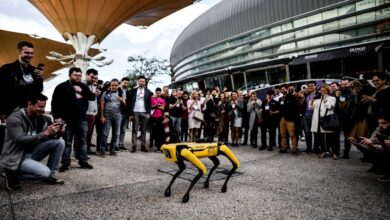AI, Robotics, and Sensors: The Future of Farming

A recent article published in the journal Agronomy comprehensively explored the integration of artificial intelligence (AI), sensors, and robotics in modern agriculture, highlighting their potential to revolutionize farming practices and drive sustainable development. The researchers aimed to investigate the specific roles of these technologies in enhancing agricultural efficiency, productivity, and environmental sustainability.
Background
Traditional agriculture, crucial for global food security, faces challenges such as inefficient supply chains, low productivity, land degradation, declining soil fertility, heavy reliance on inorganic fertilizers, water resources, and emerging pest resistance. These issues threaten the sector’s long-term viability and contribute to unsustainable practices. Moreover, traditional agriculture struggles to meet the demands of a growing global population, leading to rural decline, population reduction, and an aging agricultural workforce.
To address these challenges, smart agriculture emerges as a promising solution, prioritizing the optimization of production processes, the adoption of environmentally friendly practices, and the enhancement of ecological sustainability. It leverages advanced technologies such as AI, robotics, the Internet of Things (IoT), data management systems, and intelligent decision-making algorithms.
The goal is to develop systems capable of monitoring, analyzing, and controlling various aspects of agricultural production, including soil health, water usage, crop management, pest and disease control, weather patterns, and market conditions.
About the Research
In this paper, the authors explored the potential of AI, sensors, and robotics to transform agriculture, with a focus on advancing smart agriculture practices. They examined how these technologies could enhance every stage of agricultural production, from pre-planting to post-harvest activities.
After introducing the concept of smart agriculture and emphasizing the pivotal role of advanced techniques in its realization, the researchers presented a comprehensive taxonomy of these technologies in the context of smart agriculture, categorizing them based on their functions, features, and application domains. Additionally, they addressed the challenges and opportunities associated with integrating these technologies into smart agriculture systems.
Subsequently, a thorough survey of the current state-of-the-art in AI, sensors, and robotics for smart agriculture was conducted. This survey covered various topics, including precision farming, crop monitoring, autonomous machinery, pest and disease detection, yield prediction, irrigation management, harvesting, post-harvest processing, and supply chain management. The authors provided detailed insights into existing systems, methodologies, and applications across different crops and regions. Furthermore, they discussed the advantages and limitations of these technologies, identified gaps in current research, and outlined future directions for exploration and development in this field.
Significance
The study revealed significant progress and impact made by AI, sensors, and robotics in smart agriculture, particularly in precision farming, autonomous machinery, and crop monitoring. These advancements have the potential to address key challenges in traditional agriculture, including low productivity, environmental degradation, and inefficient supply chains. Additionally, these technologies can enhance the quality, safety, and traceability of agricultural products, while improving the income and welfare of farmers.
However, the paper also highlighted several limitations and challenges associated with the adoption of AI, sensors, and robotics in smart agriculture. These challenges included high costs, complexity, reliability issues, interoperability concerns, scalability limitations, and considerations related to security, privacy, ethics, and social acceptance.
Furthermore, the authors emphasized the necessity for further research and development, particularly in areas such as pest and disease detection, yield prediction, irrigation management, harvesting, post-harvest processing, and supply chain management. They also suggested the importance of fostering collaboration and coordination among various stakeholders, including farmers, industry players, government entities, and society as a whole, to promote the adoption and innovation of these technologies for smart agriculture. This collaborative approach is essential for addressing existing challenges, driving further advancements, and ensuring the successful integration of AI, sensors, and robotics into agricultural practices.
Applications
Employing AI, robotics, and sensors in smart agriculture brings several key implications. Precision farming utilizes these technologies to collect and analyze data on soil, water, crops, pests, diseases, weather, and market conditions. It provides tailored recommendations for fertilization, irrigation, pest control, and harvesting, optimizing practices for individual fields, crops, and farmers.
Autonomous machinery operates with minimal human intervention, performing tasks like seeding, weeding, spraying, and harvesting. This reduces labor costs and risks while enhancing efficiency and accuracy. Crop monitoring employs AI, sensors, and robotics to track crop growth, health, and quality using drones, satellites, cameras, and smartphones. It detects pests, diseases, and stresses, offering timely feedback to farmers and managers.
Additionally, AI, sensors, and robotics enable pest and disease detection, identifying and classifying crop threats through drones, cameras, and smartphones. Early warnings and prevention measures are provided, enhancing crop protection. Yield prediction estimates crop yield and quality, aiding in planning, management, and marketing.
Irrigation management optimizes water supply and demand, reducing waste and improving efficiency. Harvesting machinery operates autonomously, reducing labor and enhancing precision, while post-harvest processing employs these technologies to preserve and monitor product quality. Finally, supply chain management optimizes the flow of agricultural products from farm to fork, enhancing efficiency, transparency, and sustainability.
Conclusion
Overall, the study summarized that technologies such as robotics, AI, and sensors are driving a paradigm shift in agriculture, moving toward smart and sustainable practices. It emphasized the need for continuous work in areas such as sensor robustness, environmental parameter optimization, and the design of intelligent sensors to improve smart practices in the agricultural field.
Journal Reference
Zhang, B.; Qiao, Y. AI, Sensors, and Robotics for Smart Agriculture. Agronomy 2024, 14, 1180. https://doi.org/10.3390/agronomy14061180, https://www.mdpi.com/2073-4395/14/6/1180.



